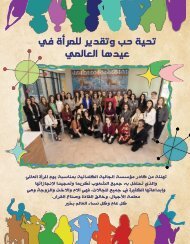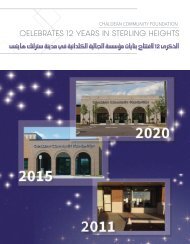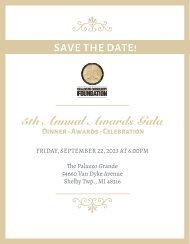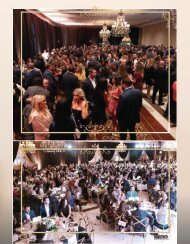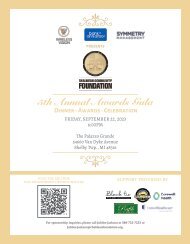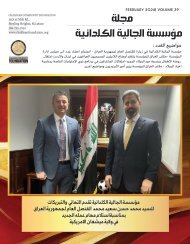Create successful ePaper yourself
Turn your PDF publications into a flip-book with our unique Google optimized e-Paper software.
Peter and Samira Essa at Willow Run Airport with family and friends when they arrived to America.<br />
started to actually create printed invitations at this<br />
time in Iraq,” said Fr. Boji. “In the 40s and 50s,<br />
they hosted two important events, the Henna and<br />
the Begana where they took food from the bride’s<br />
house to the groom’s house.”<br />
This happened on the same day, typically a Saturday,<br />
but at different times of the day. “The henna<br />
then was a lot simpler than it is today in America,”<br />
said Fr. Boji. “It was just a few women and the close<br />
relatives with the mother-in-law.”<br />
During this time period some wedding ceremonies<br />
would take place in the early morning hours<br />
around 2 or 3 a.m. “The tradition was that the father<br />
of the bride would not allow his daughter to<br />
leave the house without being married,” said Fr.<br />
Boji. “Usually early morning and it lasted a long<br />
time. Priests recited prayers and blessings.”<br />
After the prayers and blessing, the bride and<br />
groom were taken out and paraded in a circle to<br />
the entire village. The drums and zurna were<br />
played. “As the bride and groom passed, people in<br />
the town, young men, would bring them a bottle of<br />
Arak. “It was a sign of respect,” said Fr. Boji.<br />
Riding a horse was common in the 60s and 70<br />
but not typically ridden by the bride. “They would<br />
put a mattress, the cover sheets and the pillows on<br />
a horse and young boys around 9 or 10 years old<br />
would sit on the mattresses,” said Fr. Boji.<br />
Those invited to the wedding would gather at<br />
the groom’s house for dinner. The next morning,<br />
guests would gather again and bring the envelopes,<br />
the wedding gifts. “They usually cooked Pakota<br />
(Barley dish) for the guests the next day.”<br />
There were traditional celebrations of dancing.<br />
“Usually before the wedding was a couple of days<br />
of gathering and some of the youth of that neighborhood<br />
would dance. But the day of the wedding<br />
itself, whomever wanted to dance could dance but<br />
it was not as big tradition for all weddings.”<br />
In the 50s and 60s, the wedding ceremonies<br />
were moved to 10 or 11 in the morning. “The<br />
groom’s family would go to the bride’s family house<br />
and the youth boys about 15 or 16 years old would<br />
go to the door with a bottle of Arak and a chicken<br />
for mezza later,” said Fr. Boji. “This was like in the<br />
form of payment. They would not let the bride out<br />
of the house until this was paid.”<br />
This is how the tradition became that the<br />
groom’s family paid for the wedding. Later the bottle<br />
of Arak and the chicken were replaced with money.<br />
There was a similar tradition where the groom<br />
would go the bride’s house and young men would<br />
hit the bottom of their shoes with sticks until the<br />
bride’s family gave them Arak and a Chicken.<br />
Although these traditions were left behind in Iraq,<br />
the significant traditions that remain in America are<br />
the prayers. The actual wedding vows today are from<br />
the Latin Rite. The blessing of the bride and groom<br />
and the rings are from Chaldean traditions.<br />
“In 30s and 40s, vows were between the father of<br />
the groom and the father of the bride,” said Fr. Boji.<br />
“The father of groom was proposing and the father<br />
of bride in is accepting. This was part of the ceremony.<br />
In the engagement back then, it was not the<br />
bride and groom, it was groom’s father to the bride’s<br />
father. These traditions are in the liturgical books.”<br />
In Iraq, the groom buys the dresses, “the Chass,”<br />
said Fr. Boji. “The brides’ family would kind of pay<br />
it back with making the food and putting money<br />
in the coat pocket of the groom. The entire town<br />
would see that the bride’s family would pay the<br />
groom back in this way.”<br />
Also in Iraq, the marriages were arranged up<br />
until the 70s and early 80s.<br />
Peter and Samir Essa knew each other for about<br />
three days before they married and didn’t speak to<br />
each other until about three days after the wedding.<br />
“Here is the picture of the two of us on the<br />
day Peter side hi to me and I said hi back,” said<br />
Samira as she pointed to the photo.<br />
That was almost the limit of their conversations<br />
as Peter only spoke English and Samira only<br />
spoke Arabic and Chaldean.<br />
“My mother-in-law would translate for me,”<br />
said Samira, ‘when I first arrived in the United<br />
States. She spoke Sourath. I loved it because I felt<br />
like I was speaking to my own mother.”<br />
During these days of their wedding there was<br />
a revolution in Iraq and King Faisal’s regime was<br />
overthrown. Peter and Samira were unable to leave<br />
Iraq. “My passport was stamped by King Faisal,”<br />
said Samira. “It was no longer valid. I needed a new<br />
stamp by the Prime Minister.”<br />
As an American, Peter was taken by the Em-<br />
THEN AND NOW continued on page 28<br />
<strong>FEBRUARY</strong> <strong>2018</strong> CHALDEAN NEWS 27





